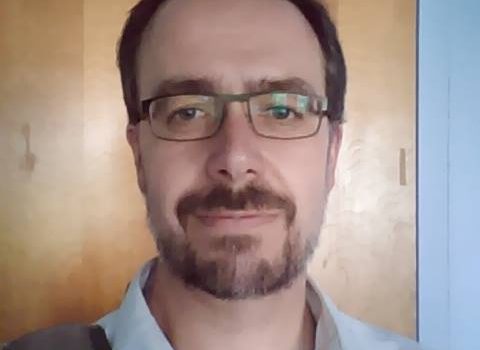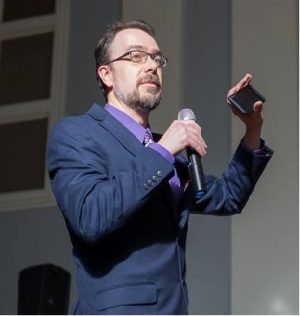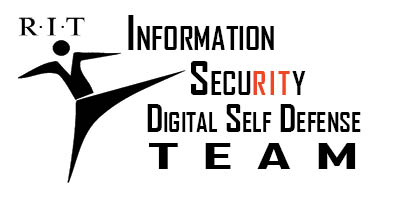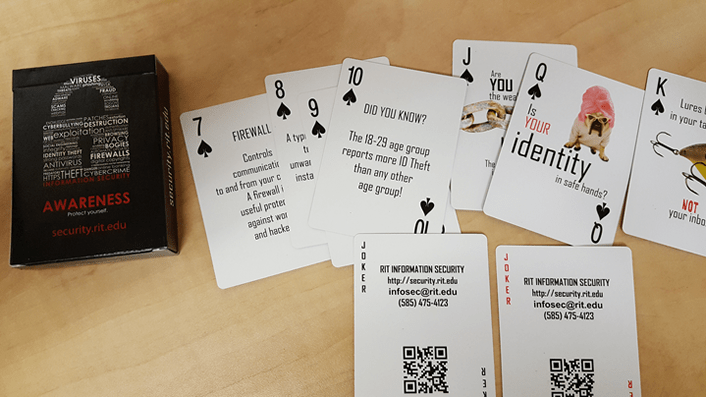
Episode 008: Kirk St Amant–Reflective Listener and Leader
Category:Higher Education,introversion,Introverted Leadership,introverts,Podcast,Social NetworkingPodcast: Play in new window | Download
Subscribe: Spotify | Amazon Music | iHeartRadio | Podchaser | TuneIn | Deezer | RSS
Episode 008 Show Notes: Kirk St. Amant
Introduction

Key concepts
- Being a reflective listener
- Teasing out detail
- Debilitating stage fright
- Being who you are
- The echo chamber of social media
Quotable
And I think that’s a major challenge for introverts, is trying to maximize that ability you have to sit and listen, balanced against the expectation that we should have an extroverted communication style for the most part. And helping individuals realize that silence is not necessarily a negative thing.
I’m not the ideal person you want in sort of an outreach season. I’m not a meet-and-greet kind of person. I’m not going to be the person who walks into the room and introduces myself to every single person there, but I am the person who is willing to sit there and listen to everybody who wants to come through and talk about what needs to be done differently or better next time.
I think the biggest thing is you’ve got to be who you are and the biggest impediment is for individuals to think they’ve got to become an extrovert to be successful. Or they’ve got to force their way to be an extrovert in a certain way. We’ve all got to be introverts or extroverts over the course of our professional lives. That’s a given, but it’s got to be according to parameters that work for you with your personality….
Resources or Products Mentioned in this Episode
- Society for Technical Communication
- Rochester Institute of Technology
- American Medical Writers Association
Links
- Follow Hope for the Introvert on Twitter
- Like my page on Facebook
- Support me on Patreon
- Get swag for Hope for the Introvert and Introverted Leadership at Zazzle
Transcript
Ben: Kirk, it’s great to have you back again. Today we’re going to continue our discussion about what it’s like to be an introvert in the workplace and for you specifically to be an introvert in academia. So one of the things we’ve asked our guests is, what do you find to be most challenging as an introvert in your profession?
Kirk: Great question. The need to be on. And by on. I mentioned earlier, you pretend to be an extrovert in many cases and so the need to be on during these instructional times–and these aren’t just in the classroom teaching the class, but they’re in the hallway talking with students. They’re during office hours, being with students and in many cases, I mean you can go for an entire day where you’re in complete “On mode” for eight to ten hours a day, between teaching and meeting with students and talking with students and meeting with colleagues and stuff. And that can be exhausting and I think it’s a matter of–I don’t know about you or other introverts–but I need decompression time after this happens. And it’s kind of helping people realize that I’m going to not be interacting a whole lot for this next little bit here, because I just need time to sit and breathe and just be alone for a little bit.
Kirk: That’s the thing. One challenge. And I think the other challenge is whenever you create sort of this persona of the extrovert teacher, if you will, in the classroom, students come to expect that of you every time they encounter you. And so when they meet you out in the community and begin to engage with you and they realize you don’t talk a lot, and my word, you’re dull, well, yes, I probably am. [Ben laughing] So it’s kind of helping them realize that no, this, this thing in the classroom is kind of, this is what I do in that particular venue and this is who I am most of the rest of the time. So I think that’s kind of the big challenges. Making these worlds meet if you will, and getting other individuals you work with to adapt to them, that this is okay. This is how this person works.
[bctt tweet=”The challenge is whenever you create sort of this persona of the extrovert teacher, if you will, in the classroom, students come to expect that of you every time they encounter you.” username=”hopeintrovert”]
Kirk: I think many of us do this, whether introverts or extroverts. It’s a spectrum. We move back and forth between different points on it and so I think getting individuals to understand that we’re not all one or all the other, but we move back and forth, and don’t take this as meaning anything other than the fact that I’m in my decompression time right now. I’m not trying to be the classic things that we’re probably all accused of–aloof, silent, quiet, you know, standoffish, whatever it might be. That this is just who I am and kind of getting individuals to realize, oh no, this is just another facet of that person’s personality. I think that’s a great challenge because they’re so accustomed to seeing you in this ON mode, if you will.
Ben: Yeah, and I’ve mentioned in prior podcasts talking with friends that we see each other at conferences and that’s the only other time people really see us and what they see at conferences is not how we are in our private life. We may appear to be very outgoing, but it does drain us and we do need to get that time where we can just go away, retreat and recharge.
Kirk: Yes, it’s essential. [laughing]
Ben: Kirk, what do you believe are your biggest strengths as an introvert and how have you leveraged them?
Kirk: I think they are twofold. I think one is listening and it’s the ability to want to sit and listen and process. I think we do cue behavior in terms of, yes, I understand, to kind of prompt the conversation, but to want to let the other party talk as much as is needed and simply listen and process there as they’re speaking I think is a great asset. I think another great asset is, let’s call it this tenacious desire, to want to tease out details as people are speaking. So one of the things that I’ve had people kind of been confused about with my behavior is they’ll present something to me and then I’ll follow up with a slew of questions before I say anything. And that slew of questions is essentially designed to focus in on what the person is talking about–to actually try to get to the heart of what is the specific focus we should be addressing. And I think that’s a strength, because it helps the person you’re speaking with–and you also–realize what the actual thing you wish to focus on is. And in many cases, then you can work backwards from that focus to figure out what’s the overall situation you’re talking about. I’ve got a problem. Well, when does it happen? Where does it happen? What seems to be present when it’s–when it’s taking place? What seems to be the cause…? You’re zoning in on what is actually the nature of the problem and you can work out from that,
Kirk: I think they’re sort of focused questioning in relation to exchanges where you ask the person you’re interacting with to focus in on or zone in on that thing they’re talking about. I think that’s greatly beneficial, as one thing that introverts tend to do is to want to focus in on very specific things through sort of targeted, repeated questioning, “There’s this problem.” “Well, tell me about it. Where does it happen? When does it seem to happen? What seems to be causing it? What seems to be the environment that’s causing it?” To sort of focus in until you really get to the heart of the matter, I think is beneficial and I think it’s something many introverts do inherently, and I think it’s helpful both for the person with whom you’re speaking and for you because you begin to better understand the nature of what you’re going to be talking about. What is actually the problem we’re discussing. Can we get to it? And so I think that’s a strength that…at least in my mind.
Ben: I’m laughing a little bit as you’re talking about this, and mainly because I know that for me and my temperament type, I’m not the most patient person in the world, and I lose focus when people meander when they’re talking to me. And I’m seeing this as this is a way to kind of get them focused and, as you mentioned, it’s good for them. It’s good for you. Also.
Kirk: Maybe, Ben, you’ve experienced the same thing, but there’s a tendency I think for many introverts to focus in on things. You mentioned like what your temperament is. Is it your temperament, or you process information in a certain way? So it’s like, no, can we keep it this way because I’m gonna process down this line of thought first and we can come back to that other thing later. And I think that’s a benefit, because it helps the person with whom you’re interacting kind of focus in on what they’re talking about. And let’s face it, I’m doing it right now. We tend to talk all over the place as we’re extemporaneous–extemporaneizing on stuff. (God, I think I just made up a word) [Ben laughing], as you’re kind of going and that kind of focus helps bring things back. And again, I think that’s something that tends to be associated with introverted behavior as far as I understand it. Those are what I see as the strengths, the ability to listen and then to ask questions to try to guide in on things.
Kirk: At the same time, I think those are weaknesses, and by weaknesses I mean, people have certain perceptions of what that behavior means, particularly if you’re unfamiliar with interacting a lot with introverts who operate in that way. And so I’m willing to bet you and many other introverts have encountered things like, you know, this person is, they’re passive, they’re standoffish. They’re not necessarily positive things that come with a lack of desire to communicate continually in the moment, or the dogged pursuit of trying to focus questions in on things. You mentioned, for example, temperament and not being patient with things. Well that’s, you know, again, notice you’re contextualizing that in a certain way, which is not, it’s contextualized as negative, but it doesn’t have to be. And I think that’s a major challenge for introverts, is trying to maximize that ability you have to sit and listen, balanced against the expectation that we should have an extroverted communication style for the most part. And helping individuals realize that silence is not necessarily a negative thing.
Kirk: I hope that made sense.
Ben: No, I think it does.
Ben: And “silence”. I am married to an extrovert and she finds silence difficult to deal with because she’s processing–she processes verbally. But then when she gets silence in response, she doesn’t know what the other person–if it’s an introvert like me–she doesn’t necessarily know what the other person is thinking about things because they are processing it internally and not verbally, and that’s been one of those challenges we’ve learned to work through over the years. It’s interesting, because I had referred to temperament and patience. I’m getting a little–I don’t want to go deep into it–but looking at the Keirsey Temperament Theory, and I know we haven’t talked about this kind of stuff much at all, but where I fit in that as a Rational–not irrational, but some may beg to differ–but a Rational and I am all about kind of objective, “Let’s get to the point” sort of thing. So that’s why I’m referencing that temperament part where the touchy-feely stuff doesn’t–I don’t empathize well, I guess is what it really boils down to. I’m more interested in “Oh, is there a problem here?” Let’s work on the problem sort of thing rather than just being available to listen. So I, even as an introvert, I have to watch myself in terms of wanting to jump in and provide a solution when there’s not necessarily even a solution that’s being asked for.
Kirk: Gotcha.
Ben: So in terms of your profession, in terms of the Society for Technical Communication and I think American Medical Writers Association, in what ways have you been an influencer or leader?
Kirk: I think in many ways it’s the ability to have discussions with folks. And again, the ability to–I want to listen to what you have to say and let me ask some questions to try to tease this out. I think that way I think is very beneficial. There are times for different kinds of leadership. There are times you need extroverted leadership and there are times when you need introverted leadership, and I think in a few cases I’ve been fortunate where I’ve hit at the time where that desire for let’s pull back and be introspective about this for a bit has been beneficial. Before doing a lot of the stuff I do with the STC, I was involved with an academic organization called the Council for Programs in Technical and Scientific Communications, CPTSC, (there’s a mouthful,) and it was at a time I think where the organization needed to sort of stop for a moment and take a breath and figure out where it was going to go next.
Kirk: And in that case, I think that, you know, the fact that I’m a little bit more on the reserved side was beneficial. I’m not the ideal person you want in sort of an outreach season. I’m not a meet-and-greet kind of person. I’m not going to be the person who walks into the room and introduces myself to every single person there, but I am the person who is willing to sit there and listen to everybody who wants to come through and talk about what needs to be done differently or better next time. And I think again, we’re back to those sort of balance things. I think you probably have experienced this also, but from my perspective, the best thing to do is to have a leadership team, if you will. Where you do have an introvert and an extrovert who are both working together in some sort of leadership position, and I think that way you can really maximize the benefits of both personality types. And I’ve been very fortunate in the past to have been in a situation where I have worked with some people who were just amazing extroverts, but knew how to work with an introvert also and vice versa.
Ben: Oh, very cool. So what recommendations would you have for introverts who want to become influencers or leaders?
Kirk: I think it’s a matter of figuring out what benefits you bring as a leader, and again, as introverts, there’s a tendency to listen more–to want to think through fully before responding–and then to be very careful in how you articulate responses. I think that’s a very, very good sort of skill set to have and as a matter of figuring out at what point in time do I need to use that skill set based upon the needs of the organization or the group. And I think it’s also a matter of figuring out what are my “limitations” as a leader because I’m not an extrovert, what methods can I use to address that? I might not be the best public speaker on earth, but I’m pretty good at blog posts, so maybe I’ll do more leadership through these kinds of postings, then I will through podcasts or to public orations if you will.
Kirk: So it’s a matter of realizing there are other ways to achieve this objective of, as a leader, building a sense of community, reaching out to others. It’s a matter of what works with my personality type. I think as introverts we all have kinds of crutches for lack of a better way of putting it, for addressing situations. I’ll be honest with you, Ben, you’ve seen me speak before, right? Okay. One thing you’ll notice and people have bugged me about this, I take off my glasses when I talk, and the reason I do that is because I am–can’t see a thing without them and so it works magic for me because I really–I don’t have to worry about that sort of, I’m standing up in front of a group of people and worried about how I’m going to behave. I can’t see them. I’m lucky if I don’t walk into a wall, you know, but it’s a behavior that you learned to sort of, I’ve got to be the extrovert in the situation. We’ve all learned these different kinds of mechanisms to help us at work in these situations and it’s learning what they are and using them effectively.
Ben: It’s funny, because in my conversation with Alisa, we talked about presentation styles and for her, the key thing is to ensure that she has eye contact with one or two members of the audience to be able to engage with them and to be able to present with them. I had no idea. I think I remember you taking your glasses off. It wasn’t really apparent to me at that point, but that that’s hysterical–that you can’t see–that you do better not being able to see people to see their reactions, which in theory should make you really good at doing webinars also. [Kirk laughing] But it’s just funny because of the different approaches that we have.
Kirk: Uh huh. And it’s–we’ve all got a mechanism that we’ve designed that works for us, and it’s back to what is that mechanism? Can we really maximize it? The whole “take off my glasses and talk,” like I have debilitating stage fright. Without that I’m not speaking, but it works in large group settings where I’m communicating to a crowd. In smaller group discussions, I’ve got to be very careful about making sure I put my glasses on often enough to see what’s going on to interact. And so, it’s just learning those different behaviors and norms and realizing I didn’t realize how much I pick up on nonverbal cues in terms of just how the audience sounds, because I really can’t see them or because I can’t see their faces, I’ve become a lot more attuned to their body posture because I can see forms. I just can’t see faces. And so just realizing, oh wow, these are things that I was really picking up on before that I hadn’t realized.
Ben: Yeah, it’s–this is a really interesting discussion. I don’t know how many people do that. There could be many. I recognize when I present, when I’ve seen myself on video, there are all sorts of mannerisms that I wasn’t aware of and I tried to kind of watch those as I’m speaking, but again, in the heat of the moment, there’s no telling what might pop out. It’s interesting. Any other recommendations for introverts becoming influencers or leaders?
Kirk: I think the biggest thing is you’ve got to be who you are and the biggest impediment is for individuals to think they’ve got to become an extrovert to be successful. Or they’ve got to force their way to be an extrovert in a certain way. We’ve all got to be introverts or extroverts over the course of our professional lives. That’s a given, but it’s got to be according to parameters that work for you with your personality, and you’ve mentioned with your personality how you’ve kind of bridged that divide. I think the thing to be wary of is the thought that I need to be this kind of introvert or extrovert, or I need to do these things to be successful when being an extrovert or presenting myself as an extrovert. It’s got to be your own style that works for you. Finding that which is natural to you, because whether you’re an introvert or extrovert, you can tell if someone’s behaving unnaturally. And I think that’s the key. Is this–is what I’m going to be to try to be extroverted about things versus I can’t really do it this way. Here’s what works for me. I think that’s the major thing that’s important for folks.
[bctt tweet=”I think the biggest thing is you’ve got to be who you are and the biggest impediment is for individuals to think they’ve got to become an extrovert to be successful. Or they’ve got to force their way to be an extrovert in a certain way. ” username=”hopeintrovert”]
Ben: Kirk, this has been a great discussion. What other thoughts do you have for us today?
Kirk: I think for myself, the one area I’d like to see help with in terms of introverts and extroverts are social media, because social media for the most part as I see it is, it’s an extrovert’s medium or suite of media that is designed to project aspects of what you’re doing out to the greater population to see. And like any sort of thing that takes place in a public setting, there are certain expectations and dynamics to it that at least myself as an introvert, I don’t feel comfortable using or knowing or understanding. But I want to say that in two different sorts of concepts. The first is, as an introvert, I’d like to know more how to effectively project out to engage, but as an introvert I’d also like to see more introverts working with others to talk about. It can’t just be self projection all the time and I think that again, there’s–because you can’t see the population you’re interacting with, it’s a matter of what’s the litmus test or tests for echo that says, “This is too much, this is not enough.” How do you go from one-way broadcasting to interactive interaction through these media.
Kirk: And I think introverts and extroverts, all people have a role to play in discussing how to do this because these are very powerful media. I think the biggest fear there within is they can be echo chambers. if you’re always projecting out without the response from others speaking back, how far will you get in a line of sort of thought before you realize I could be dead wrong. And that’s an area where all of us sort of together need to figure out how to navigate these new kinds of media. It’s exciting, but it’s an opportunity for us to interact and participate and work together to build things. And I think that’s what’s key.
Ben: Well, I appreciate your time today. This has been a very insightful and interesting interview and I look forward to having you on the program again in the future.
Kirk: Looking forward to it. Thank you for the opportunity and thank you for this podcast series. It’s a great resource.
Ben: Thank you. I appreciate that.

 Prof. Kirk St. Amant and Ben Woelk discuss what it’s like to be an introvert in the classroom, how we engage students, and the role of popular culture in teaching. We also discuss how we adapt to the absence of in-person feedback mechanisms in webinars and online courses.
Prof. Kirk St. Amant and Ben Woelk discuss what it’s like to be an introvert in the classroom, how we engage students, and the role of popular culture in teaching. We also discuss how we adapt to the absence of in-person feedback mechanisms in webinars and online courses.
 Joanna Grama is a senior consultant for
Joanna Grama is a senior consultant for  Think Strategically
Think Strategically







